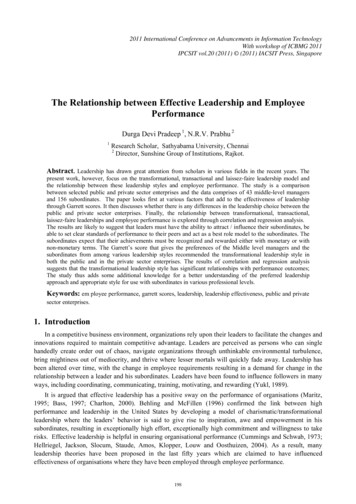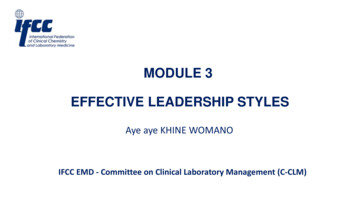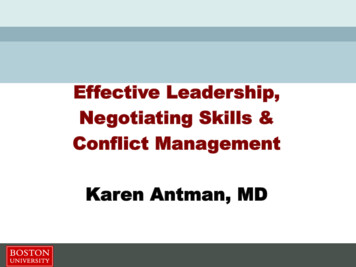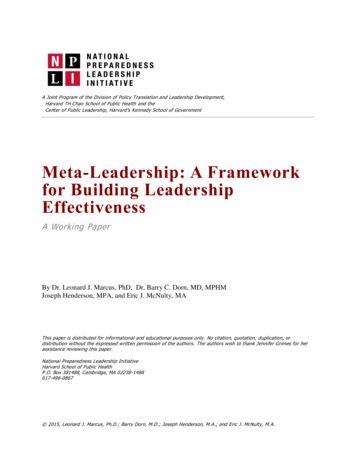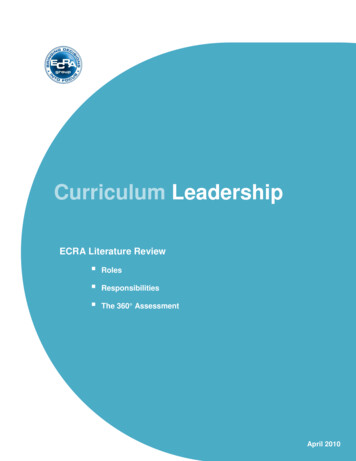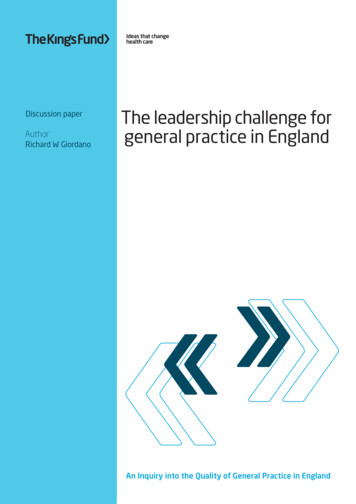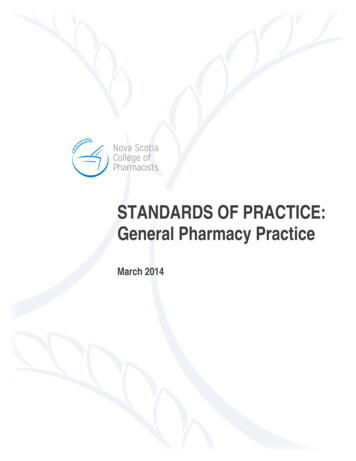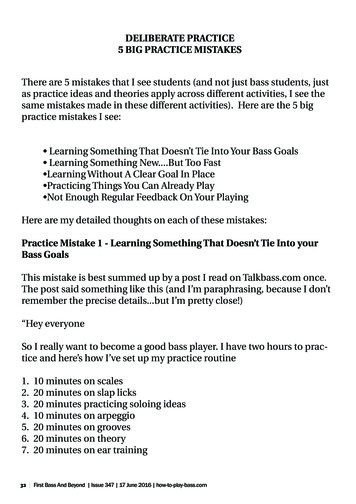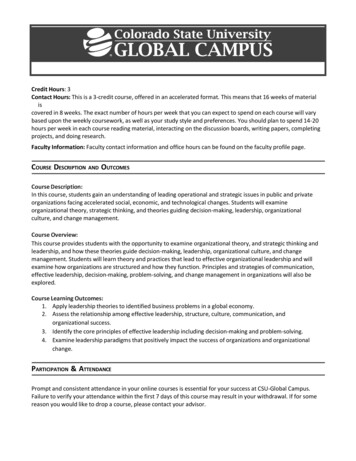
Transcription
ORG502: EFFECTIVE LEADERSHIP: PRACTICE AND THEORYCredit Hours: 3Contact Hours: This is a 3-credit course, offered in an accelerated format. This means that 16 weeks of materialiscovered in 8 weeks. The exact number of hours per week that you can expect to spend on each course will varybased upon the weekly coursework, as well as your study style and preferences. You should plan to spend 14-20hours per week in each course reading material, interacting on the discussion boards, writing papers, completingprojects, and doing research.Faculty Information: Faculty contact information and office hours can be found on the faculty profile page.COURSE DESCRIPTION AND OUTCOMESCourse Description:In this course, students gain an understanding of leading operational and strategic issues in public and privateorganizations facing accelerated social, economic, and technological changes. Students will examineorganizational theory, strategic thinking, and theories guiding decision-making, leadership, organizationalculture, and change management.Course Overview:This course provides students with the opportunity to examine organizational theory, and strategic thinking andleadership, and how these theories guide decision-making, leadership, organizational culture, and changemanagement. Students will learn theory and practices that lead to effective organizational leadership and willexamine how organizations are structured and how they function. Principles and strategies of communication,effective leadership, decision-making, problem-solving, and change management in organizations will also beexplored.Course Learning Outcomes:1. Apply leadership theories to identified business problems in a global economy.2. Assess the relationship among effective leadership, structure, culture, communication, andorganizational success.3. Identify the core principles of effective leadership including decision-making and problem-solving.4. Examine leadership paradigms that positively impact the success of organizations and organizationalchange.PARTICIPATION & ATTENDANCEPrompt and consistent attendance in your online courses is essential for your success at CSU-Global Campus.Failure to verify your attendance within the first 7 days of this course may result in your withdrawal. If for somereason you would like to drop a course, please contact your advisor.
Online classes have deadlines, assignments, and participation requirements just like on-campus classes. Budgetyour time carefully and keep an open line of communication with your instructor. If you are having technicalproblems, problems with your assignments, or other problems that are impeding your progress, let yourinstructor know as soon as possible.COURSE MATERIALSRequired:Rath, T. (2017). StrengthsFinder 2.0. New York, NY: Gallup Press. ISBN-13: 9781595620156NOTE: All non-textbook required readings and materials necessary to complete assignments, discussions, and/orsupplemental or required exercises are provided within the course itself. Please read through each coursemodule carefully.COURSE SCHEDULEDue DatesThe Academic Week at CSU-Global begins on Monday and ends the following Sunday.Discussion Boards:Be sure to submit a substantive initial discussion post by Thursday at 11:59 p.m. MT and to reply to 2 or morepeers with substantive responses by Sunday at 11:59 p.m. MT. A substantive initial discussion post completelyanswers the question presented and may add a thoughtful question pertaining to the topic. When replying topeer initial posts, discuss whether you agree with their actions, ask an inquisitive question, and recommend atleast one alternative action based on the required readings, your own research, and personal experience.Substantive replies to your peers add to a discussion. Simply stating, “I agree” or “great response” is notsubstantive.Critical Thinking:Assignments are due Sunday at 11:59 p.m. MT.WEEKLY READING AND ASSIGNMENT DETAILSModule 1: Organizational Structure and FunctionReadings:Required Ahmady, G. A., Mehrpour, M., Nikooravesh, A. (2016, September 12). Organizational structure. ProcediaSocial and Behavioral Sciences, 230, 455-462. (To view this reading, please open the link provided anddownload the "PDF full text").Musibau, A. A., Cho, N. M., Ekanem, E. U. U., & Ojochide, F. P. (2016). How organizational structure aidsbusiness performance. International Journal of Research in Commerce & Management, 7(8), 64-68. (Toview this reading, please open the link provided and download the "PDF full text").Setiawan, B. M., Putrawan, I. M., Murni, S., & Ghozali, I. (2016). Effect of organizational structure,leadership and trust on job performance of employee: A case study on employee at UniversitasTernama. International Review of Management and Marketing, 6(4). 711-721
Shafiee, H., Razminia, E., & Zeymaran, N. K. (2016). Investigating the relationship between organizationalstructure factors and personnel performance. International Journal of Management, Accounting &Economics, 3(2), 160-165. (To view this reading, please open the link provided and download the "PDFfull text").Recommended Clegg, S. (Academic). (2016). Organizational design [Streaming video]. Retrieved from SAGE Video. Colorado State University–Global Campus Library. (2017) Guide to Writing & APA.Discussion BoardIntroduction: (0 points)Your first assignment is to get to know the team of learners with whom you will be working.1. Please introduce yourself in this discussion forum. Focus your introduction on areas you feel arerelevant to your work in the course but give your introduction a personal touch as well. Share yourmajor, your location, your career aspirations, and any personal experience or knowledge that may relateto the course. You may also post a picture of yourself.2. What experience and interest do you have in leadership in an organization? How might theknowledge and skills associated with this course support your career or life aspirations?Discussion Board Post (25 points):A great way for leaders to begin solving problems with organizational structure is to ask three importantquestions:1. Is the problem the structure, or is the problem the way leadership is managing the structure?2. Does the structure of the organization match the organizational mission, vision, and goals?3. Has the design of the organization been compromised due to accommodating various employees?In your initial discussion post, respond to the questions below:1. To apply these ideas practically, describe an organization that you have been part of in the past orpresent that went through a change in structure or one that you think NEEDS to go through a changein structure.2. Answer the three guiding questions above to determine how a solution to the structure could bereached.3. What questions would you add to this list?4. How would your proposed question(s) benefit the organizational structure?Critical Thinking Option #1 (50 points)Organizational Structure and Job PerformanceBased on the course readings and resources, complete the following:Write a paper discussing how employee job performance is related to organizational structure. Provide areal-life scenario of how you have witnessed either positively or negatively, the effects of organizationalstructure on employee performance. Use an organization you work for, one that you are familiar with.Critical Thinking Option #2 (50 points)Organizational Structure and Job PerformanceBased on the course readings and resources, complete the following:Create a presentation to summarize employee job performance and how it can be affected byorganizational structure. Also, include a real-life scenario you have witnessed either positively ornegatively, that reflects the effects of organizational structure on employee job performance. Use an
organization you work for, one that you are familiar with.Module 2: Communication StrategiesReadings:Required Beakley, J. E. (2016). Supervisor-subordinate communication: Workplace bullying and the tyrannicalmum effect. International Journal of Business and Management, 11(2), 31. Retrieved article/view/55335 (To view this reading, please openthe link provided and download the "PDF full text"). Hall, A. (2016). Exploring the workplace communication preferences of millennials. Journal ofOrganizational Culture, Communications, and Conflict, 20, 35-44. Lloyd, J. (2018). Communication Key to Leadership: Clarity is essential for effective communications.Health Care Registration: The Newsletter for Health Care Registration Professionals, 28(1), 8–9. (To viewthis reading, please open the link provided and download the "PDF full text"). Murray, R. (2018). Workplace communications – five ways for leaders to make it better. NZ Business Management, 32(7), M16. (To view this reading, please open the link provided and download the "PDFfull text").Discussion Board (25 points):Describe a situation where you witnessed inappropriate or unethical communication. The situation doesnot have to be in a work environment.In your post, respond to the questions below:1. Was anything said or done as a result of the communication? If so, explain what was done andby whom and whether you agree with the action that was taken. If no action was taken, what do youbelieve should have been done?2. Based on the required readings for this module as well as other reliable outside research ifapplicable, what action(s) would have helped this situation?Critical Thinking Assignment Option #1 (80 points):Successful Practices for Workplace Communication PlanBased on the weekly required readings, imagine a scenario within a team where poor communication, suchas misunderstandings, inactive listening, playing The Blame Game, using intimidation tactics, etc. areprevalent. Also within this team, basic oral and written communication skills are sorely lacking. Teammembers often mispronounce key terms and jargon, use flawed grammar, and often write using acronymsand misspellings more suitable to text messaging than a professional workplace. All these indicators pointto team members not being able to effectively write suitable memos or properly interact with customers.To correct this situation, develop a plan in the form of a paper with at least three action items to movethe team from poor communication to effective oral and written communication.Research proven communication methods through four scholarly journal articles. Conclude the plan withjustification as to why the three action items are your preferred choices.Your well-written plan must adhere to the following parameters: Be 4-5 pages in length, not including the title and reference pages.Be supported by six references, with at least four scholarly references. Remember, you must supportyour thinking and prior knowledge with references; all facts must be supported; in-text references usedthroughout the assignment must be included in an APA-formatted reference list.Review the grading rubric, which can be found in the Module 2 folder.Be formatted according to the CSU-Global Guide to Writing & APA.
.Critical Thinking Assignment Option #2 (80 points):Successful Practices for Workplace Communication PresentationAs a team leader in an organization where the team has experienced a heightened amount of conflictdue to poor communication, create a training session through a presentation for the team aboutcommunicating effectively in the workplace. This is your opportunity to demonstrate your public speakingskills, which is an expectation in a leadership role. This is also your opportunity to show your creativity ifyou are so inclined.Based on the articles from this week’s required readings create a presentation using a webcam,smartphone, or other video tools to train the team regarding best practices for workplace communication.Your well-crafted 5-8 minute presentation must include 6-10 slides, not including the title and referenceslides, and audio. Please include six references, at least four being scholarly/peer-reviewed discoveredthrough the CSU-Global library. You may use the readings in the module; however, you must include twoadditional sources. Review the grading rubric for this assignment, to understand exactly how you will begraded. Use the CSU-Global library Visual Presentation section for resources to help you create yourpresentation. Contact your instructor if you have questions about the assignment.Live Classroom:1- hour session with a provided PowerPoint presentationModule 3: Decision Making and Problem SolvingReadings:Required Michailidis, E., & Banks, A. P. (2016). The relationship between burnout and risk-taking in workplacedecision-making and decision-making style. Work & Stress, 30(3), 278–292. (To view this reading, pleaseopen the link provided and download the "PDF full text"). Shen, K-Y, & Tzeng, G-H. (2018). Advances in multiple criteria decision making for sustainability:Modeling and applications. Sustainability, 10(5), 1-7. (To view this reading, please open the link providedand download the "PDF full text.")Discussion Board (25 points):Based on your experience and course readings, what decision-making model do you think would be mosteffective in your organization? Why do you believe this is the best choice? What other options should theorganization consider? What are some characteristics commonly found among leaders who are effectivedecision makers?Critical Thinking Assignment Option #1 (80 points):Leadership Problem Solving MemoImagine you are the leader of the design department in a growing organization in a high tech industry.Over the past three months, the sales in the organization have declined due to poor designs and softwaremalfunctions and your department has been identified as part of the problem. As the department leader,you want to involve your team in identifying and solving any problems within your department.Using the module required readings, videos, and your personal experience, prepare a two-page memo toyour team. Provide a problem-solving process the organization can establish for such situations toproperly identify such problems. Justify why you believe the approaches are best for the department.
NOTE: Keep in mind that you are not trying to solve the problem of the decline in sales, but rather youare introducing a problem-solving protocol. You do not know what is causing the problem, so solvingit is not an option at this point. Your well-written memo must adhere to the following parameters:2 pages in length using APA memo format (Links to an external site.), but with the inclusion of APAcitations and referencing.Be supported by six references, with at least four credible references. Remember, you must support yourthinking and prior knowledge with references; all facts must be supported; in-text references usedthroughout the assignment must be included in an APA-formatted reference list.Review the grading rubric within this assignment for more detail on how this assignment will be graded.Citations are to be formatted according to the CSU-Global Guide to Writing & APA. Since this is a memo,the APA structure is not an expectation.Critical Thinking Assignment Option #2 (80 points):Leadership Problem Solving PresentationImagine you are the leader of the design department in a growing organization in a high tech industry.Over the past three months, the sales in the organization have declined due to poor designs and softwaremalfunctions and your department has been identified as part of the problem. As the department leader,you want to involve your team in identifying and solving any problems within your department. Using themodule required readings, videos, and your personal experience, prepare a two-page memo to yourteam. Provide a problem-solving process the organization can establish for such situations to properlyidentify such problems. Justify why you believe the approaches are best for the department.NOTE: Keep in mind that you are not trying to solve the problem in this assignment, but rather you areintroducing a problem-solving protocol. You do not know what is causing the problem, so solving it isnot an option at this point.Your well-crafted 3-5 minute presentation must include 4-7 slides, not including the title and referenceslides, and audio. Please include six references, at least four being scholarly/peer-reviewed discoveredthrough the CSU-Global library. You may use the readings in the module; however, you must includetwo additional sources. Review the grading rubric for this assignment, to understand exactly how youwill be graded.Use the CSU-Global library Visual Presentation (Links to an external site.) section for resources tohelp you create your presentation. Contact your instructor if you have questions about the assignment.**Looking Ahead to Module 6**One of the Critical Thinking assignments in Module 6 requires you to interview a leader in yourcommunity or organization regarding ethics.Begin to consider your options and schedule a time to conduct your interview prior to Module 6. Keepin mind the schedule of your requested interviewee.Be sure to review the Critical Thinking Option #2 assignment in Module 6 for details.Module 4: Organizational Change ProcessesReadings:
Required Andersson, G. (2015). Resisting organizational change. International Journal of Advanced CorporateLearning, 8(1), 48-51. (To view this reading, please open the link provided and download the "PDF fulltext"). Brown, G. (2018). Leading change. Leadership Excellence Essentials, 35(7), 34-36. Espedal, B. (2017). Understanding how balancing autonomy and power might occur in leadingorganizational change. European Management Journal, 35(2), 155-163. Jensen, G., & (Russ) Pirasteh, R.,M. (2016). Change: The only constant. Industrial Management, 58(2),27-30,5.Recommended Harnett, T. (2018). Building resilience to changing conditions. Chief Learning Officer, 17(9), 40–41. (Toview this reading, please open the link provided and download the "PDF full text"). Neves, P., Almeida, P., & Velez, M. J. (2018). Reducing intentions to resist future change: Combinedeffects of commitment-based HR practices and ethical leadership. Human Resource Management, 57(1),249–261. (To view this reading, please open the link provided and download the "PDF full text").Discussion Board (25 points):Reflect on a change you have experienced or been a part of either professionally or personally within anorganization. Describe how it was introduced and led. Based on what you have read this week aboutchange, what would you have done differently? Explain your reasons.Critical Thinking Assignment Option #1 (80 points):Organizational Change Planning SessionYou are a leader of a large healthcare organization. Your organization is acquiring another hospitalgroup which may involve major changes in policies and procedures including human resources as youmerge the two organizations. You have scheduled a planning session with your top managers.
Your assignment is to develop a planning document for the meeting. The document should be in standardAPA paper formatting and include: Describe the types of change the organization could experience and how to create procedures fordealing with each. An analysis of potential change approaches to implement these changes in both organizations. Recommendations for dealing with resistance to change. You must support your plan with a minimum of four scholarly sources.Critical Thinking Assignment Option #2 (80 points):Organizational Change Planning PresentationYou are a leader of a large healthcare organization. Your organization is acquiring another hospitalgroup which may involve major changes in policies and procedures including human resources as youmerge the two organizations. You have scheduled a planning session with your top managers.Your assignment is to develop a planning document for the meeting. The document should include: Describe the types of change the organization could experience and how to create procedures fordealing with each. An analysis of potential change approaches to implement these changes in both organizations. Recommendations for dealing with resistance to change. You must support your plan with a minimum of four scholarly sources.Portfolio Project Reminder:Review the two assignment options for the Portfolio Project, listed in Module 8.This week, you should begin to examine an organization that is of interest to you. Next week, you willsubmit a 300- to 400-word paper describing the topic of your project.*Be sure to review the Portfolio Project Rubric in Module 8 for details.Module 5 Organizational Culture:Readings:Required Friedman, H., & Gerstein, M. (2017). Leading with compassion: the key to changing the organizationalculture and achieving success. Psychosociological Issues in Human Resource Management,5(1), 160-175. Moyce, C. (2015). Culture change. Management Services, 59(1), 28-30. Pulay, G. (2017). The three legged system of organisational integrity. Review of Economic Studies andResearch Virgil Madgearu, 10(2), 159-175. Warrick, D. D. (2017). What leaders need to know about organizational culture. Business Horizons, 60(3),395-404.(To view this reading, please open the link provided and download the "PDF full text").Recommended Anonymous.(2018). 3 Keys to effective culture change. . Physician Leadership Journal, 5(4), 14.Discussion Board (25 points):Choose an organization where the culture needs improving, such as your work, an association, or churchyou belong to, or the like. Based on your required readings, identify what elements of the culture needsimprovement. Then write what action(s) should be taken to improve the culture.
Critical Thinking Assignment Option #1 (80 points):Changing a Company’s CultureChoose a company that values organizational culture. Describe what the company did to make its culturebetter overall, not just a better place to work. (A basic Google search of leading companies should giveyou ample options to choose from.)Analyze the secret to their success.Address these points in your paper:1. Describe (briefly) the culture before the company changed its culture2. List the steps the company took to change its culture.3. Describe (briefly) the impact on employees and other statistics such as increased retention rates.4. Analyze the effectiveness of the steps to change the culture.5. Evaluate whether the steps were efficient and effective or whether other steps could have beentaken.6. Recommend how these changes could be used in a company whose culture is causing highemployee turnover and poor image and detracting from its competitive advantage.Critical Thinking Assignment Option #2 (80 points):What Makes a Company Great?Find four companies considered to have good”cultures. Create a video presentation using your choice ofwebcam or smartphone, to describe what makes each company’s culture good. (Creativity isencouraged!)Address these points in your presentation:1. Name of company and number of employees2. Description of the culture that is available from sources such as articles and videos found within theCSU-Global library.3. The impact of company culture on the organization’s image and brand4. Evaluate and assess the positive impact on employees and its image/brand, or recommend what theycould do to further improve culture.Portfolio Project Milestone (25 points):This week, you will turn in a one-page paper describing the topic and plan for your Portfolio Project.Include the following information:1. The working title of the project2. The scope of your research3. How you might, or intend to, apply the knowledge gained from this project. That is, how will yourfindings be useful to you as a leader in your current or future organization?Live Classroom:1- hour session with a provided PowerPoint presentationModule 6: Organizational EthicsReadings:Required Kalshoven, K., Dijk, H. v., & Boon, C. (2016). Why and when does ethical leadership evoke unethicalfollower behavior? Journal of Managerial Psychology, 31(2), 500-515.
Lašáková, A., & Remišová, A. (2015). Unethical leadership: Current theoretical trends andconceptualization. Procedia Economics and Finance, 34, 319-328. (To view this reading, please open thelink provided and download the "PDF full text.")Yuan, Y., Yi Lu, L., Tian, G., & Yu, Y. (2018). Business strategy and corporate social responsibility. Journalof Business Ethics, 1-19.Recommended Blair, C. A., Helland, K., & Walton, B. (2017). Leaders behaving badly: The relationship betweennarcissism and unethical leadership. Leadership & Organization Development Journal, 38(2), p. 333-346.Discussion Board (25 points):Links between corporate culture and ethics can take two directions. On one hand, corporate culture canbe viewed as a fundamental ingredient in systematizing ethics in organizations. On the other hand,culture can be considered the backbone of corporate ethics, to the extent that occasionally the termsethics and culture are confused.Describe the connections between culture and ethics. What is the potential for organizational culture toserve as a means of improving ethics in an organization?Critical Thinking Option #1 (80 points)Organizations and EthicsEthics in an organization does not necessarily begin at the top but must be embraced by leadership toinfluence the organization’s ethically based decisions, goals, and strategies that drive the organizationforward.Reflect back on an ethical dilemma or situation you have encountered within your organization. Thesituation was handled both appropriately and professionally as a result of effective and successfulleadership practices within your workplace.1.2.3.4.Write a communication to the stakeholders of the organization as if you were the CEO of the organization;addressing the following:The ethical situation in question and the steps it took to get thereEvaluate whether or not the culture of the organization provided a climate that nurtured this type ofbehaviorBriefly describe the impact this had on the employees and stakeholdersMake recommendations for how the organization can change to ensure this type of action does notrepeat itself and how they can reform their ethical approach if not already reformedCritical Thinking Option #2 (80 points)Organizational Ethics InterviewEthics in an organization do not necessarily begin at the top but must be embraced by leadership toinfluence the organization’s ethically based decisions, goals, and strategies that drive the organizationforward.Conduct an interview with a leader in your community and/or workplace. Discuss their experience withethics in the workplace, and ask them to reflect back on an ethical issue they have encountered.Write an analysis of your interview and the takeaways you learned from the interviewee.
1.2.3.4.5.6.Make sure to read the assignment in its entirety before conducting your interview to assist you in theformation of interview questions and the direction the interview should take. Include the following:The background of the person you interviewed, including title and organization. We ask you to includegeneric names to respect the sensitivity of the nature of ethical issues.The leader’s perspective on ethics in the workplace.The ethical issue in question and the sequence of events that he/she felt led up to the issue.Briefly describe the impact this had on the employees and stakeholders.Generate your own recommendations on how the organization could have avoided this ethical issue.Defend or dispute the perspective of the leader you interviewed in regards to ethics.Module 7: Leadership ParadigmsReadings:Required Rath, T. (2007). Part 1 - Finding Your Strengths: An Introduction in StrengthsFinder 2.0- Discover YourClifton Strengths. (p. 1-32). Washington D. C.: Gallup Press. Rath, T. (2007). Part 2 - Applying Your Strengths in StrengthsFinder 2.0- Discover Your Clifton Strengths.(p. 33-36). Washington D. C.: Gallup Press. Rath, T. (2007). The 34 Themes and Ideas for Action in StrengthsFinder 2.0- Discover Your CliftonStrengths. (p. 37-173). Washington D. C.: Gallup Press. (please read the themes pertaining to yourassessment). Bargau, M. (2015). Leadership versus management. Romanian Economic and Business Review, 10(2),197-204. Silva, A. (2016). What is leadership? Journal of Business Studies Quarterly, 8(1), 1-5.Recommended Boomer, L. G. (2019). 10 skills for digital leadership. Accounting Today, 33(1), N.PAG. (To view thisreading, please open the link provided and download the "PDF full text"). Rigoni, B., Asplund, J., & Nelson, B. (2016). Strengths-based development: Leadership’s role. GallupBusiness Journal, 1. (To view this reading, please open the link provided and download the "PDF fulltext").Discussion Board (25 points)Follow the link in the back of your StrengthsFinder 2.0 book, and take the self-assessment. Uponcompletion, read up on your top five strengths in the book and in your customized leadership guide. Thisself-assessment provides you with amazing insight into how to utilize these strengths to be a moreeffective leader.Reflect on which of your top five strengths has been the most instrumental to you in your current (ormost recent role).List your top 5 strengths as determined from the assessment.Discuss the ways you think these strengths can help you to further develop your leadership skills andperformance within your organization?Did anything surprise you about your StrengthsFinder 2.0 Self-Assessment results?(This book will continue with you as a student in the MSOL program, so keep it close!)Module 8: Effective Leadership
Readings:Required Croft, L., & Seemiller, C. (2017). Developing leadership competencies. New Directions for StudentLeadership, 2017(156), 7–18. (To view this reading, please open the link provided and download the"PDF full text"). Kollenscher, E., Popper, M., & Ronen, B. (2018). Value-creating organizational leadership
StrengthsFinder 2.0. New York, NY: Gallup Press. ISBN-13: 9781595620156 NOTE: All non-textbook required readings and materials necessary to complete assignments, discussions, and/or supplemental or required exercises are provided within the course itself. Please read through
